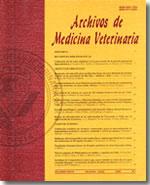Effect of three different anti-mycotoxin additives on broiler chickens exposed to aflatoxin B1
Main Article Content
Abstract
The growth of filamentous fungi on food often causes, aside from its deterioration, the mycotoxin production which determines economic losses in poultry industry, such as decreased productivity and injuries on poultry's carcass. Adsorbents based on yeast cell wall from Saccharomyces cerevisiae, which contain esterified glucomannan, are an alternative to reduce the mycotoxins bioavailability. The aim of this study was to compare in vitro and in vivo the performance of new three anti-mycotoxin additives (AMA) based on yeast cell wall from Saccharomyces cerevisiae. The adsorption process was quantified in vitro, and the data obtained when plotted with Hill's equation indicated a cooperative process. Then, the three different AMA were tested for its ability to reduce the effects of aflatoxins in the diet of growing broiler chickens. The addition of 1 mg kg-1 aflatoxin B1 to the diets of broilers caused a negative change on the performance parameters besides increasing liver weight, fatty degeneration and liver necrosis. The addition of two different kinds of AMA (0.2%) could reverse such effects. In conclusion, AMA 1 and 2 are additives with good potential for application on animal production. The AMA 3 ingredients must be re-tested alone for its adsorption capacity. These are the first data reported from Brazil anti-mycotoxin additives with preliminary isothermal analysis. Since beneficial characteristics of S. cerevisiae cell wall in animal industry are strain dependent, this study suggests two new promising alternatives to ameliorate mycotoxin problem.

